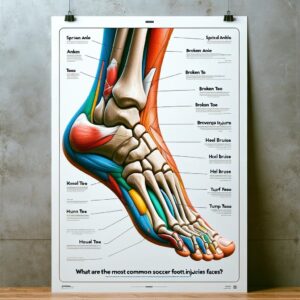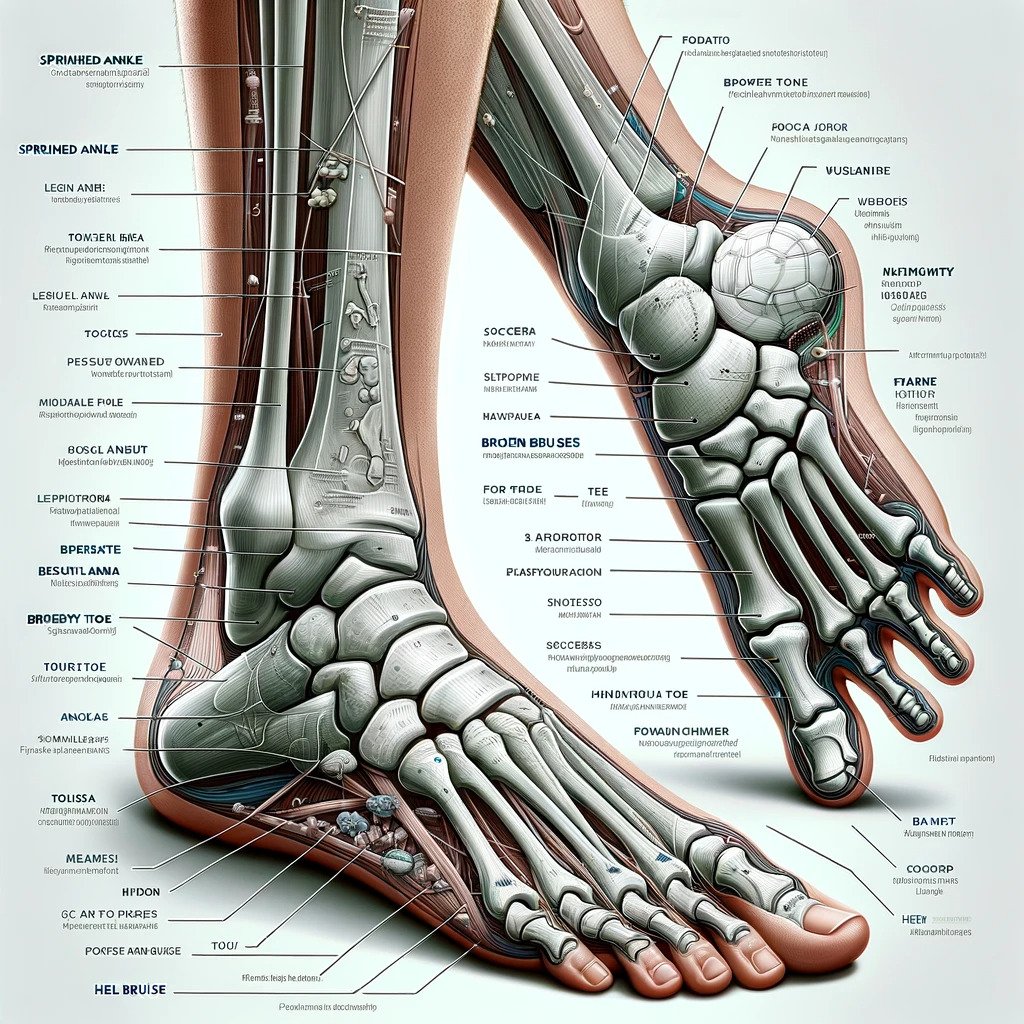As one of the fastest-growing sports, soccer has gained immense popularity across various ages, bringing with it a focus on safety. Players are constantly exposed to movements like running, stopping, sliding, and tackling, which can lead to injuries.
Acute injuries often occur from a direct impact, like during a tackle, or from a player making a sudden cutting or planting motion. Imagine a player, in the heat of the game, starting a sprint or taking a risky shot, only to end up with a traumatic injury to the ankle or lower extremity. Conversely, overuse injuries stem from repetitive stress on the foot and ankle, exacerbated by excessive side-to-side movements that are quite prevalent in soccer.
It’s not just about being physically fit; soccer players also need to be mentally prepared. They must constantly watch out for situations that may bring about an injury. This means being aware of their surroundings and understanding when to take on a challenge or when to hold back. This balance of mental alertness and physical readiness is crucial in preventing injuries.
What Are The 10 Most Common Soccer Foot Injuries Athletes Face?

In my years of playing soccer, from recreational kickabouts to professional matches, I’ve seen and experienced a variety of foot and ankle injuries. The list of the most common injuries comprised those that can escalate if left unchecked, a scenario I’ve witnessed too often in both high school and collegiate levels.
Whether it’s a sprained ankle from an awkward landing or a stress fracture from repetitive impact, these injuries, while prevalent, can be effectively managed with proper care and treating strategies.
As players, understanding these risks and knowing how to prevent them is crucial, so situations don’t get out of hand.
1. Ankle Sprains
Ankle sprains are among the most common injuries in soccer, often resulting from landing awkwardly, planting the foot incorrectly, or turning too sharply. As a soccer player myself, I’ve seen teammates sprain their ankles by stepping on uneven surfaces, making a sharp move to get the ball, or colliding with another player. The injury typically involves stretching or tearing of the ligaments associated with the ankle.
The immediate aftermath? The ankle may bruise, swell, and become painful almost immediately after the incident.
Managing and Preventing Ankle Sprains
When an ankle sprain does occur, it’s crucial to know how to deal with it. The RICE method – rest, ice, compression, and elevation – is often the first line of treatment. For more severe cases, a doctor may prescribe wearing a compression boot, a soft cast, or using crutches to keep the weight off the injured ankle. Personal experience has taught me that taking immediate and appropriate action can significantly reduce recovery time and prevent further damage.
2. BLISTERS
Blisters, though often not seen as severe, are one of the most common skin disorders seen in soccer. They appear as small bubbles of fluid beneath the skin, caused by shear forces. The location on the foot determines whether they are painful or not. From personal experience, I can attest that blisters can range from a minor nuisance to a significant impediment, depending on their severity and treatment. Not treated properly, they can lead to complications like cellulitis or infection.
The formation of a blister happens when there’s a tear between the top three layers of skin, often due to a buildup of moisture and temperature changes. To prevent recurring blisters, various methods are reported, including Vaseline, antiperspirants, and moleskin. Though studies to support the use of these methods are limited, many players find them effective.
Managing and Preventing Blisters
When treating a blister, it’s crucial not to drain it immediately and avoid creating multiple puncture sites. Proper care includes trying to preserve the roof of the blister, as its removal can increase pain and the risk of infection. In cases where activity must return quickly, using a topical antibiotic gel can be effective. Additionally, products like Engo patches have been known to help prevent blisters.
3. Achilles Tendonitis
Achilles Tendonitis is a common injury among soccer players, often resulting from overuse or not warming up properly. Even something as simple as wearing the wrong sneakers can contribute to this condition. Players typically experience pain at the back of the ankle, and while it may seem harmless at first, requiring just a little rest, if left untreated, it can lead to a more severe condition like an Achilles tendon rupture.
Managing and Preventing Achilles Tendonitis
Patients with this condition often feel pain in the heel or along the tendon when running or even walking. There’s no quick fix for an inflamed Achilles Tendon. Initial treatment usually involves icing the area for 15-20 minutes several times a day. If the pain worsens or persists, it increases the chances that a visit to the doctor is necessary. From my experience, incorporating proper warm-up routines and wearing the right footwear are crucial in both treating and preventing Achilles Tendonitis in soccer.
4. SUBUNGUAL HEMATOMA/BLACK TOENAIL
Subungual Hematoma, commonly known as a black toenail, is a frequent issue among soccer players and runners. This condition arises when blood starts accumulating under the toenail due to trauma – often caused by wearing shoes that are too short or too long. The result is a purple or black discoloration under the nail, depending on the extent of blood involved. In my experience, seeing this injury in soccer is not unusual, especially after intense training or games.
Managing Black Toenail in Athletes
When it comes to black toenails, the best treatment depends on the severity of the injury. If the blood accumulation is greater than 50%, there’s a chance the toenail might come off. For less than 50% involvement, the new nail will typically grow out, pushing the damaged one off. While it can be painful, draining the toenail does not usually affect training or games.
Oftentimes, medical professionals may drain the toenail if it is painful, but if it’s not painful, they might leave it untouched. Occasionally, there’s a need for the toenail to be removed completely. This decision, however, is usually made by a medical professional, based on the level of discomfort and risk of further injury. As a former soccer player, I’ve learned that timely intervention and proper footwear are key to both treating and preventing this condition.
5. Plantar Fasciitis
Plantar Fasciitis, often linked with Achilles Tendonitis, is a common source of pain for many a soccer player. This condition manifests as a sharp, stabbing pain at the bottom of the heel. From personal experience, I can attest that this pain is most noticeable and intense during the first few steps in the morning. It’s a discomfort that sneaks up silently but can significantly impact a player’s performance on the field.
Addressing the Plantar Fasciitis
Dealing with Plantar Fasciitis involves understanding the strain placed on the heel. The pain is not just a morning nuisance; it signals an underlying issue that needs attention, especially for active soccer players. Early recognition and appropriate intervention can greatly alleviate the discomfort and prevent further complications.
6. TURF TOE
Turf toe, a condition involving the big toe joint, is a familiar adversary for athletes who frequently engage in running and sudden changes of direction. This injury commonly occurs when the toe is bent too far, resulting in a sprained joint. It involves stretching or injuring the tendons and ligaments around the joint. While it’s most common among players on artificial turf, it can also occur on other playing surfaces.
Getting Through Turf Toe
The key to managing turf toe lies in effective treatment. This includes rest, ice, non-steroidal anti-inflammatories, and sometimes shoe modifications like splinting or taping. In severe cases, immobilization in a boot or occasionally, surgery may be necessary. As a former soccer player, I’ve learned that turf toe can be a debilitating injury if not treated immediately. Non-treatment can lead to chronic changes and prolonged discomfort, affecting a player’s ability to perform on the field.
7. Stress Fractures
Stress fractures in soccer are a direct consequence of overuse and repeated impacts on the foot and leg. As a soccer enthusiast who’s played for a long time, I’ve seen how these injuries occur often due to overtraining. A stress fracture is a small crack in a bone that develops from the continuous stress and strain soccer players put on their feet and legs.
Recognizing and Addressing Stress Fractures
The challenge with stress fractures is their subtle onset; they don’t just appear one day but develop over time due to repeated stress. Knowing when to rest and how to balance training can significantly reduce the risk of this injury. As a player, understanding and recognizing the early signs of a stress fracture is crucial for timely treatment and prevention.
8. CALCANEAL APOPHYSITIS
Calcaneal apophysitis, commonly known as Sever’s disease, is a common yet under-diagnosed condition causing heel pain in children who play soccer. This injury typically affects kids aged 8-14, coinciding with their growth spurts. The growth plate in the heel bone becomes irritated due to the impact and stress from playing soccer, especially where soft tissue attachments are involved. It’s not unusual to see a child limping after practice or games due to this discomfort.
Addressing the Pain and Aiding Recovery
The main symptom is pain during activity with relief following rest. There might also be swelling or bruising. The treatment for calcaneal apophysitis often involves rest, ice, and possibly NSAID’s for pain management. In some cases, heel lifts, orthotics, or even temporary immobilization are recommended. For more severe cases, custom orthotics may be prescribed. These interventions have proven to be effective in providing relief and aiding recovery, allowing kids to return to their beloved sport safely.
9. Jones Fracture
A Jones Fracture is a specific type of fracture that happens in the fifth metatarsal, one of the long bones leading to the toes, particularly near the pinky toe. This injury is quite distinctive and can be a significant setback for soccer players, given the intense footwork involved in the sport.
H4: Understanding and Managing the Fifth Metatarsal Fracture
This fracture, while not as common as others, requires careful attention due to its location and the stress placed on the foot during soccer activities. It’s crucial for players to recognize the symptoms and seek appropriate treatment to prevent complications and ensure a safe return to the game.
10.Sever’s Disease
Sever’s Disease, often in a similar place to Achilles Tendonitis, is an injury that occurs primarily in young athletes. It’s the result of overuse and overtraining, and can easily be confused with Achilles Tendonitis. However, Sever’s Disease is distinct, characterized by severe pain in the heel, which becomes particularly evident especially during activities like running.
Differentiating and Managing Sever’s Disease
In my experience working with young soccer players, it’s crucial to distinguish this condition from other injuries. While it might seem okay to continue playing, consulting a doctor is advisable to ensure proper care. A simple solution like inserting a heel pad into cleats can provide significant relief, allowing players to continue their passion for soccer without exacerbating the condition.
Conclusion
Understanding and addressing soccer foot injuries is paramount for players at all levels. From common ailments like ankle sprains and blisters to more complex conditions like Jones Fractures and Sever’s Disease, each injury presents its unique challenges. Knowledge about these injuries, combined with preventive measures and appropriate treatments, is key to maintaining foot health and ensuring longevity in the sport.
Soccer, with its dynamic and physically demanding nature, calls for players to not only focus on skill development but also on the well-being of their feet, the very tools that allow them to excel on the field. Remember, taking care of your feet is not just about recovery; it’s about respecting and protecting the fundamental assets that keep you playing the beautiful game.
Frequently Asked Questions
How do you treat soccer feet?
Treatment for soccer-related foot injuries typically involves rest, ice, compression, and elevation (RICE method). More specific treatments depend on the injury, such as using orthotics for plantar fasciitis, immobilization boots for fractures, or physical therapy for sprains. Always consult a healthcare professional for a tailored treatment plan.
Why does my foot hurt when I play soccer?
Foot pain during soccer can be due to overuse injuries, improper footwear, or acute injuries like sprains or fractures. Conditions like plantar fasciitis or turf toe are also common in soccer players. It’s important to evaluate the type of pain and seek medical advice for accurate diagnosis and treatment.
What to do when your foot gets stepped on in soccer?
If your foot gets stepped on during soccer, immediately apply ice to reduce swelling and pain. If the pain persists or if there’s significant bruising or deformity, seek medical attention to rule out fractures or severe soft tissue injury.
What is the most painful injury in soccer?
The most painful injury in soccer varies individually but can include severe sprains, fractures, and ligament tears. Achilles tendon ruptures and severe cases of plantar fasciitis are particularly painful and debilitating.
Does football damage your feet?
Football (soccer) can lead to foot injuries due to the physical demands of the sport, including repetitive impacts and stress on the feet. Proper footwear, training techniques, and adequate rest can help mitigate the risk of foot damage.
What are the foot injuries from kicking?
Common foot injuries from kicking in soccer include metatarsal fractures, bruised toenails, and sprains. Repetitive kicking can also lead to overuse injuries such as tendinitis or plantar fasciitis.

